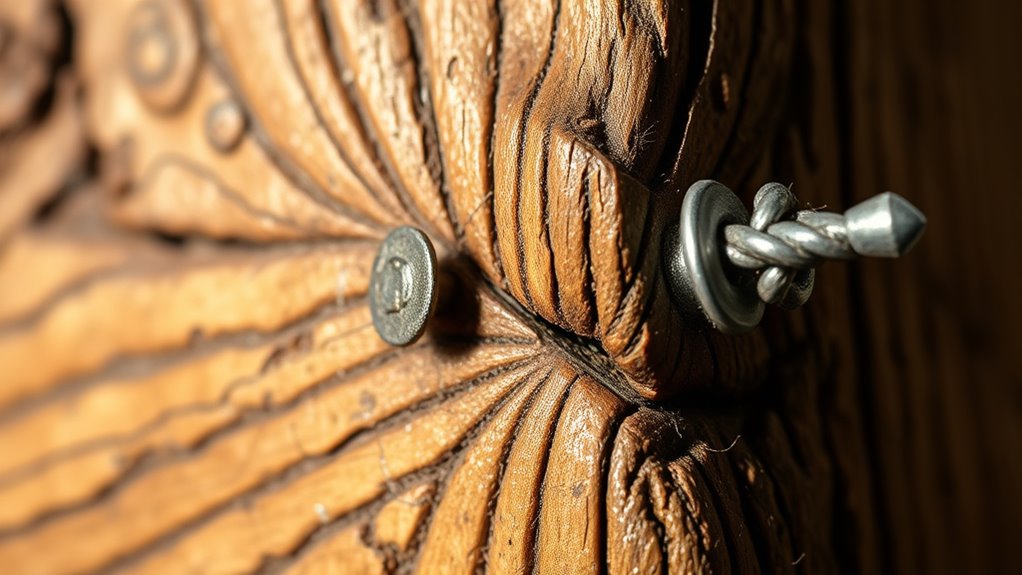When choosing nails for fine woodwork, consider whether you want authenticity or modern strength. Cut nails, with their rough, tapered look, evoke antique charm and are perfect for restoring historic pieces. Wire nails, smooth and uniform, are easier to work with and ideal for sleek, contemporary projects. Both styles serve different purposes, so understanding their unique qualities can help you pick the best for your project—there’s more to uncover about their differences ahead.
Key Takeaways
- Cut nails provide an authentic, vintage appearance ideal for restoring or emphasizing historical craftsmanship.
- Wire nails offer a sleek, uniform look suitable for modern woodwork requiring strength and efficiency.
- The rough texture of cut nails enhances rustic charm, while smooth wire nails facilitate easier installation.
- Selection depends on project purpose: use cut nails for authenticity, wire nails for durability in contemporary designs.
- Understanding their distinct manufacturing processes helps choose the best nail type for matching aesthetic and functional needs.

Traditional nails have long played an essential role in fine woodwork, offering a reliable and authentic fastening method. When you choose nails for your project, you’re not just considering their function but also their nail aesthetics — how they contribute to the overall look of your craftsmanship. Historically, nails served as one of the earliest fastening methods, dating back centuries before the advent of modern screws or adhesives. Their presence in furniture and architecture reflects a legacy of craftsmanship and durability that many artisans still value today. The choice between cut nails and wire nails influences not only the strength of your work but also its appearance and historical accuracy.
Traditional nails offer authentic fastening and add vintage charm to woodwork.
Cut nails, often associated with traditional woodworking, boast a distinct, tapered shape created by unrolling sheet iron and cutting it into nails. Their rough, textured surface gives them an antique charm, perfectly suited for restoring period pieces or achieving an authentic, vintage look. Because of their manufacturing process, cut nails tend to have a more irregular shape, which can add to the rustic character of your project. They’re ideal if you want your work to reflect historical fastening methods, where nails were often handmade or produced with limited machinery. Their nail aesthetics evoke a sense of craftsmanship and authenticity, making them a favorite among restorers and antique furniture makers. Additionally, the manufacturing process of cut nails contributes to their distinctive appearance and historical appeal.
Wire nails, on the other hand, are produced through modern cold-heading processes, resulting in a uniform, smooth shank with a consistent point. They’re easier to drive and often more affordable than cut nails, making them practical for contemporary woodworking. While their appearance is more modern and less suited for antique projects, wire nails offer excellent holding power and resistance to bending or breaking under pressure. If your focus is on durability and efficiency rather than historical accuracy, wire nails are a sensible choice. They blend well with contemporary finishes and clean designs, offering a sleek, minimalist look that complements modern aesthetics.
Ultimately, your decision hinges on the style and purpose of your woodwork. If you’re restoring a historic piece or aiming to highlight traditional craftsmanship, cut nails will serve you best, emphasizing authenticity and the beauty of age. However, if you’re constructing something functional with a modern touch, wire nails provide strength, consistency, and ease of use. Both types of nails have their place, but understanding their differences helps you select the right fastening method that enhances the overall project. Whether you prioritize nail aesthetics or historical fastening methods, your choice should align with the story you want your finished piece to tell.
Frequently Asked Questions
Which Nail Type Is More Environmentally Friendly?
You’ll find that wire nails are more eco-friendly because they often use eco-friendly materials and have better sustainability benefits. They typically require less energy to produce and can be recycled more easily, reducing environmental impact. By choosing wire nails, you support sustainable practices in fine woodwork, helping to minimize waste and promote the use of eco-friendly materials. Overall, wire nails are a greener option for your projects.
How Do Nails Affect the Longevity of Wood Projects?
Nails greatly influence your wood project’s longevity; think of them as the bones that support your structure. Nail corrosion caused by moisture can weaken joints over time, just as rust slowly eats away iron. Additionally, wood expansion can loosen nails, leading to cracks or warping. Choosing corrosion-resistant nails and considering how wood expands guarantees your project stays strong and durable for years, much like a well-built, aging ship.
Are There Safety Concerns With Using Traditional Nails?
You should be aware of nail safety when working with traditional nails, as improper handling can lead to woodworking hazards like puncture wounds or eye injuries. Always wear safety glasses and gloves, and make certain nails are securely hammered to prevent accidents. Keep your workspace clean and organized to avoid tripping or mishandling. Following proper safety procedures minimizes risks, making your woodworking experience safer and more enjoyable.
Can Wire Nails Be Reused or Recycled?
Wire nails can be reused or recycled, but their reuse potential is limited. You can often straighten them carefully and reuse them in non-structural projects. For recycling, check with local scrap or metal recycling facilities, as wire nails are typically made of steel or other metals. Keep in mind that recycling options depend on local programs, so always verify if they accept small metal items like nails.
What Are the Cost Differences Between Cut and Wire Nails?
Ever wondered why some nails cost more than others? Cut nails tend to be pricier due to their historical usage and specific nail installation techniques, which often require more labor and craftsmanship. Wire nails, being mass-produced and more modern, are usually cheaper. If you’re aiming for authenticity or a vintage look, you might pay extra, but for quick projects, wire nails save you money. Which option fits your project best?
Conclusion
As you work with fine wood, imagine the quiet elegance of a perfectly nailed joint, each nail a tiny anchor holding history in place. Whether choosing the sturdy cut nail or the flexible wire, your hands shape timeless beauty. Think of the gentle tap of the hammer, the gleam of polished wood, and the satisfaction of a flawless finish. With each nail, you’re creating more than furniture—you’re crafting enduring artistry that stands the test of time.









